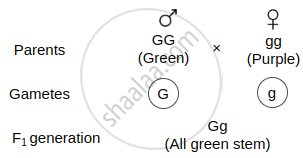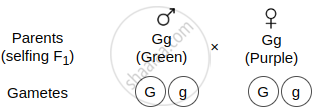Advertisements
Advertisements
Question
A green stemmed tomato plant denoted by (GG) is crossed with a tomato plant with purple stem denoted by (gg).
- What colour of the stem would you expect in their F1 progeny?
- In what ratio would you find the green and purple coloured stem in plants of F2 progeny?
- What conclusion can be drawn for the above observations?
Solution
(i) All the plants in F1 progeny will be of green coloured stem.

(ii) Cross for F2 progeny is:

F2 progeny -
| G | g | |
| G | Gg (Green) |
Gg (Green) |
| g | Gg (Green) |
gg (Purple) |
Phenotypic ratio = Green : Purple = 3 : 1
(iii) According to the finding above, purple stems are subordinate to green stems. Thus, according to the rule of dominance, only the dominant characteristic was present in F1. Purple stem in F2 indicates that the alleles for purple stem were inherited but were not expressed in F1, nevertheless. Only in F2 under homozygous circumstances did they get expressed.
APPEARS IN
RELATED QUESTIONS
Describe quantitative inheritance controlled by two pairs of genes.
Define the term heredity.
Hybridization between Tt × tt gives rise to the progeny of ratio ______.
Who is regarded as the father of genetics?
A heterozygous violet-flowered pea plant is crossed to another homozygous violet- flowered pea plant. What percent of the progeny plants will have the recessive trait, i.e., white flowers?
If a round, green seeded pea plant (RRyy) is crossed with a wrinkled, yellow seeded pea plant (rrYY), the seeds produced in the F1 generation are ______.
To study the natural phenomenon of inheritance, Mendel selected pea plants. Which of the following properties were suitable for their studies?
(i) Plants would easily self-pollinate or cross-pollinate in nature.
(ii) Plants were easily grown in garden soil with a considerably shorter generation time.
(iii) Pea plants do not require true-breeding for hybridization experiments.
(iv) Many parts of the plant such as pod, seed, flower, cotyledons showed distinct phenotypes.
Read the following and answer from given below:
According to Mendel, one gene controls the expression of one character only. The ability of a gene to have multiple phenotypic effects because it influences a number of characters are an exception. The gene has multiple phenotypic effects because its ability to control two or more characters can be seen in cotton. In cotton, a gene for the lint also influences the height of the plant, size of the ball, number of ovules, and viability of seeds.
Which of the following statements is not correct regarding genes with multiple phenotypic effects?
The genotype of a plant showing the dominant phenotype can be determined by ______.
Test Cross is a cross between:
